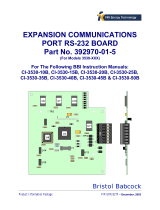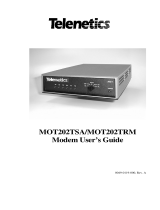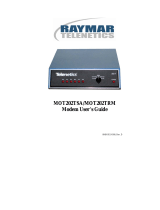
CI-9600TF Section 3 Modem Installation / 3-1
Section 3
MODEM INSTALLATION & SETUP PROCEDURES
Caution
PC board components can be damaged by electrostatic discharge (ESD) during handling, i.e.,
disassembly, reassembly, and test procedures. Use grounded wrist straps and surface pads when
working near or handling any Bristol Circuit Board. Refer to Bristol supplement manual S14006 for proper
ESD grounding and handling techniques.
3.1 INSTALLATION INSTRUCTIONS
Bristol’s 9600 bps - PSTN Modem is intended for use on the Public Switched Telephone Network (PSTN)
operating in North America as illustrated in Figures 1-1 & 3-26.
Installation of the modem versions is provided as follows:
Section 3.1.1 - 3530-10B, -50B & -15B Modem
Section 3.1.2 - 3530-20B & - 25B Modem
Section 3.1.3 - 3530-45B Modem
Section 3.1.4 - 3530-55B Modem
NOTE:
The final installation step for each 3530-XXX instructs the user to, “configure the 3530-XXX using a PC
equipped with either the Bristol TMS or UOI program.”
9600 bps - PSTN Modems are powered by the 3530-XXX’s Auxiliary Power Output Connector. Units
shipped from the factory, with a modem installed, have the Auxiliary Power Output set ON in the standard
load shipped with the product.
If you want the modem powered continuously, and
• you have since re-downloaded your standard load, -or-
• you are running an ACCOL load other than the standard load shipped from the factory, -or-
• you are installing a modem for a unit which originally shipped without a modem,
then you MUST set the Auxiliary Power Output to ON. This can be accomplished, for standard loads,
using the TeleFlow Menu System (TMS), by setting the Auxiliary Power Output Default to ON via the
Radio Communications Setup Menu (See Section F.8.5). If you are NOT using one of the standard loads,
you must use the SYS_3530 Module in your ACCOL Load to set the Auxiliary Power Default ON/OFF
signal to ON. (This signal is Entry 1 in Parameter List 4 of the SYS_3530 Module, see ‘SYS_3530’
section in the ACCOL II Reference Manual, document# D4044).
3.1.1 Installing a 9600 bps Modem into a 3530-10B, 15B or 50B
3530-XXX modems (associated with TeleFlow -10B, TeleRTU -15B & TeleFlow Corrector -50B) are
mounted on a Modem Mounting Bracket which in turn is installed on a Radio/Modem Mounting (see
Figures 3-1 & 3-2). To install a modem into a 3530-10B/15B or 50B, follow steps 1 through 9 below. Note:
The procedure for installing and configuring a TeleFlow 3530-10B, TeleFlow Corrector -50B or TeleRTU -
15B is covered in Instruction Manual CI-3530-10B, CI-3530-50B or CI-3530-15B respectively.
1. Disconnect power from the 3530-XXX (shut down or place under manual control any critical
processes prior to disconnecting power).
2. Open the Instrument Front Cover. To open the Instrument front Cover, remove the lock, if
present, and turn each of the three captive screws a quarter (1/4) turn counterclockwise.































